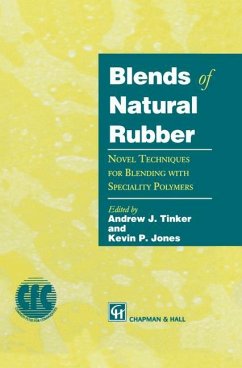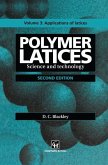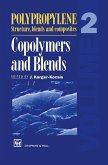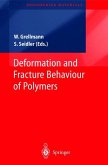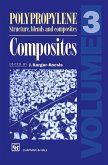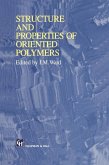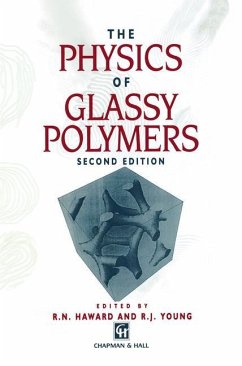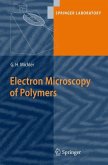K. C. Jones, Andrew Tinker
Blends of Natural Rubber
Novel Techniques for Blending with Specialty Polymers
K. C. Jones, Andrew Tinker
Blends of Natural Rubber
Novel Techniques for Blending with Specialty Polymers
- Gebundenes Buch
- Merkliste
- Auf die Merkliste
- Bewerten Bewerten
- Teilen
- Produkt teilen
- Produkterinnerung
- Produkterinnerung
Blends of natural rubber with speciality synthetic rubbers, such as nitrile rubber and ethylene propylene rubbers, have, in the past, failed to combine the best properties of polymers, resulting in a poor return in terms of added value from the blending process. The idea of blending synthetic rubbers with natural rubbe is certainly not a new one, but it is only now that this can be shown to be possible with consistently positive resluts, but eh use of novel techniques which this book describes, giving valuable information on the technology required and the results which can be achieved. Blends…mehr
Andere Kunden interessierten sich auch für
![Polymer Latices Polymer Latices]() D.C. BlackleyPolymer Latices269,99 €
D.C. BlackleyPolymer Latices269,99 €![Polypropylene Structure, blends and Composites Polypropylene Structure, blends and Composites]() Karger-KocsisPolypropylene Structure, blends and Composites121,99 €
Karger-KocsisPolypropylene Structure, blends and Composites121,99 €![Deformation and Fracture Behaviour of Polymers Deformation and Fracture Behaviour of Polymers]() Wolfgang Grellmann / Sabine Seidler (eds.)Deformation and Fracture Behaviour of Polymers161,99 €
Wolfgang Grellmann / Sabine Seidler (eds.)Deformation and Fracture Behaviour of Polymers161,99 €![Polypropylene Structure, blends and Composites Polypropylene Structure, blends and Composites]() J. Karger-Kocsis (ed.)Polypropylene Structure, blends and Composites161,99 €
J. Karger-Kocsis (ed.)Polypropylene Structure, blends and Composites161,99 €![Structure and Properties of Oriented Polymers Structure and Properties of Oriented Polymers]() WardStructure and Properties of Oriented Polymers226,99 €
WardStructure and Properties of Oriented Polymers226,99 €![The Physics of Glassy Polymers The Physics of Glassy Polymers]() HawardThe Physics of Glassy Polymers161,99 €
HawardThe Physics of Glassy Polymers161,99 €![Electron Microscopy of Polymers Electron Microscopy of Polymers]() Goerg H. MichlerElectron Microscopy of Polymers79,99 €
Goerg H. MichlerElectron Microscopy of Polymers79,99 €-
-
-
Blends of natural rubber with speciality synthetic rubbers, such as nitrile rubber and ethylene propylene rubbers, have, in the past, failed to combine the best properties of polymers, resulting in a poor return in terms of added value from the blending process. The idea of blending synthetic rubbers with natural rubbe is certainly not a new one, but it is only now that this can be shown to be possible with consistently positive resluts, but eh use of novel techniques which this book describes, giving valuable information on the technology required and the results which can be achieved. Blends of Natural Rubber is an invaluable source of information for all those working in the area of rubber technology and polymer blend technology.
Hinweis: Dieser Artikel kann nur an eine deutsche Lieferadresse ausgeliefert werden.
Hinweis: Dieser Artikel kann nur an eine deutsche Lieferadresse ausgeliefert werden.
Produktdetails
- Produktdetails
- Verlag: Springer / Springer Netherlands
- Artikelnr. des Verlages: 978-0-412-81940-7
- 1998.
- Seitenzahl: 276
- Erscheinungstermin: 31. Dezember 1997
- Englisch
- Abmessung: 241mm x 160mm x 20mm
- Gewicht: 567g
- ISBN-13: 9780412819407
- ISBN-10: 0412819406
- Artikelnr.: 23387587
- Herstellerkennzeichnung Die Herstellerinformationen sind derzeit nicht verfügbar.
- Verlag: Springer / Springer Netherlands
- Artikelnr. des Verlages: 978-0-412-81940-7
- 1998.
- Seitenzahl: 276
- Erscheinungstermin: 31. Dezember 1997
- Englisch
- Abmessung: 241mm x 160mm x 20mm
- Gewicht: 567g
- ISBN-13: 9780412819407
- ISBN-10: 0412819406
- Artikelnr.: 23387587
- Herstellerkennzeichnung Die Herstellerinformationen sind derzeit nicht verfügbar.
1 Introduction - the book and rubber blends.- 1.1 Sources of problems - and solutions.- 1.2 Blends considered.- 1.3 Strategy.- 1.4 Wider implications.- 2 Measurement of crosslink density in vulcanized blends.- 2.1 Swollen-state NMR spectroscopy.- 2.2 Network visualization microscopy.- 2.3 References.- 3 Characterization of vulcanized blends by microscopy.- 3.1 Introduction.- 3.2 Light microscopy.- 3.3 Scanning electron microscopy.- 3.4 Chemical staining.- 3.5 Chemical etching.- 3.6 Transmission electron microscopy.- 3.7 SEM-based scanning transmission electron microscopy.- 3.8 Conclusion.- 3.9 References.- 4 Estimation of crosslink density by solid-state NMR spectroscopy.- 4.1 Introduction.- 4.2 Experimental procedures.- 4.3 NMR spectra of NR.- 4.4 NMR spectra of other rubbers.- 4.5 Conclusion.- 4.6 References.- 5 NR/NBR blends - basic problems and solutions.- 5.1 Introduction.- 5.2 NR/NBR41.- 5.3 NR/Krynac 34.50 blends.- 5.4 Conclusion.- 5.5 References.- 6 Improving the morphology and properties of NR/NBR blends with NR/PMMA graft copolymers.- 6.1 Introduction.- 6.2 Methods of blending.- 6.3 Phase morphology.- 6.4 Physical properties.- 6.5 Crosslinking density distribution in the blends.- 6.6 Conclusions.- 6.7 References.- 7 Improving the morphology and properties of NR/NBR blends with polychloroprene as the compatibilizing agent.- 7.1 Introduction.- 7.2 Cure systems for NR/CR/NBR blends.- 7.3 Phase morphology of NR/CR/NBR blends.- 7.4 Conclusions.- 7.5 References.- 8 NR/NBR blends - compounding for food contact applications.- 8.1 Introduction.- 8.2 Formulations for milking inflations to meet FDA regulations.- 8.3 Formulations for milking inflations to meet BGA regulations.- 8.4 Conclusion.- 8.5 References.- 9 Novel natural rubber/ethylene propylene copolymer(EPM) blends.- 9.1 Introduction.- 9.2 Dynamic vulcanization.- 9.3 Selection of dynamic cure system.- 9.4 Dynamic vulcanization of NR/EPM blends.- 9.5 The sandwich mix cycle.- 9.6 Processing behaviour.- 9.7 Vulcanization of DV blends.- 9.8 Resistance to environmental damage.- 9.9 Preferred formulation.- 9.10 Conclusion.- 9.11 References.- 10 Natural rubber/ENR-25 blends.- 10.1 Introduction.- 10.2 Designed experiments.- 10.3 Plasticizer investigations.- 10.4 Cure systems.- 10.5 Dynamic:static modulus ratios.- 10.6 Tri-blends.- 10.7 Conclusions.- 10.8 References.- 10.9 Appendix.- 11 Partition coefficients for an ester plasticizer in black-filled blends.- 11.1 Introduction.- 11.2 Identification of exuding plasticizer.- 11.3 Estimation of Diolpate partition coefficients.- 11.4 Conclusion.- 11.5 References.- 12 Improving resistance to low temperature crystallization in NR/ENR-25 blends.- 12.1 Introduction.- 12.2 Effect of incorporating Hv-BR into NR/ENR-25 blends.- 12.3 Curative level optimization.- 12.4 Conclusions.- 12.5 References.- 13 Compounding NR/ENR-25 and NR/Hv-BR/ENR-25 blends for engineering applications 158.- 13.1 Introduction.- 13.2 Optimizing plasticizer level and masterbatch ratio.- 13.3 Mixing trials.- 13.4 Single-stage mixing for crossblending and finalizing.- 13.5 NR/Hv-BR/ENR-25 blends.- 13.6 Injection moulding.- 13.7 Conclusions.- 13.8 References.- 14 Solutions to the basic problems of poor physical properties of NR/EPDM blends.- 14.1 Introduction.- 14.2 Approaches to improving NR/EPDM blend properties.- 14.3 Mixing procedures.- 14.4 Effect of EPDM modification on crosslink density.- 14.5 Effect of EPDM modification on phase morphology.- 14.6 Interaction of modified EPDM and carbon black.- 14.7 Physical properties.- 14.8 High temperature curing effects.-14.9 Modification of different EPDM grades.- 14.10 Conclusion.- 14.11 References.- 15 Compounding NR/EPDM blends for tyre sidewalls.- 15.1 Introduction.- 15.2 Properties of comparable NR/BR and NR/EPDM blend formulations.- 15.3 Development of a NR/EPDM sidewall formulation.- 15.4 Experimental design approach.- 15.5 Crack growth testing.- 15.6 Large-scale factory mixing trials.- 15.7 Compound extrusion and tyre building.- 15.8 Initial tyre tests.- 15.9 Analysis of initial tyre testing.- 15.10 Second factory tyre building and testing trials.- 15.11 Ozone and atmospheric weathering tests.- 15.12 Conclusion.- 15.13 References.- 16 Compounding NR/EPDM blends for light-coloured applications.- 16.1 Introduction.- 16.2 General experimental procedures.- 16.3 Preparation of blend compounds.- 16.4 Comparison of physical properties.- 16.5 Formulation development.- 16.6 Weathering and ozone testing.- 16.7 Conclusion.- 16.8 References.- 17 NR/EPDM blends for extruded profile weatherstrip.- 17.1 Introduction.- 17.2 General experimental procedures.- 17.3 Initial preparation and assessment of blend compounds.- 17.4 Small-scale extrusion trials.- 17.5 Formulation development and processing.- 17.6 Conclusion.- 17.7 References.
1 Introduction - the book and rubber blends.- 1.1 Sources of problems - and solutions.- 1.2 Blends considered.- 1.3 Strategy.- 1.4 Wider implications.- 2 Measurement of crosslink density in vulcanized blends.- 2.1 Swollen-state NMR spectroscopy.- 2.2 Network visualization microscopy.- 2.3 References.- 3 Characterization of vulcanized blends by microscopy.- 3.1 Introduction.- 3.2 Light microscopy.- 3.3 Scanning electron microscopy.- 3.4 Chemical staining.- 3.5 Chemical etching.- 3.6 Transmission electron microscopy.- 3.7 SEM-based scanning transmission electron microscopy.- 3.8 Conclusion.- 3.9 References.- 4 Estimation of crosslink density by solid-state NMR spectroscopy.- 4.1 Introduction.- 4.2 Experimental procedures.- 4.3 NMR spectra of NR.- 4.4 NMR spectra of other rubbers.- 4.5 Conclusion.- 4.6 References.- 5 NR/NBR blends - basic problems and solutions.- 5.1 Introduction.- 5.2 NR/NBR41.- 5.3 NR/Krynac 34.50 blends.- 5.4 Conclusion.- 5.5 References.- 6 Improving the morphology and properties of NR/NBR blends with NR/PMMA graft copolymers.- 6.1 Introduction.- 6.2 Methods of blending.- 6.3 Phase morphology.- 6.4 Physical properties.- 6.5 Crosslinking density distribution in the blends.- 6.6 Conclusions.- 6.7 References.- 7 Improving the morphology and properties of NR/NBR blends with polychloroprene as the compatibilizing agent.- 7.1 Introduction.- 7.2 Cure systems for NR/CR/NBR blends.- 7.3 Phase morphology of NR/CR/NBR blends.- 7.4 Conclusions.- 7.5 References.- 8 NR/NBR blends - compounding for food contact applications.- 8.1 Introduction.- 8.2 Formulations for milking inflations to meet FDA regulations.- 8.3 Formulations for milking inflations to meet BGA regulations.- 8.4 Conclusion.- 8.5 References.- 9 Novel natural rubber/ethylene propylene copolymer(EPM) blends.- 9.1 Introduction.- 9.2 Dynamic vulcanization.- 9.3 Selection of dynamic cure system.- 9.4 Dynamic vulcanization of NR/EPM blends.- 9.5 The sandwich mix cycle.- 9.6 Processing behaviour.- 9.7 Vulcanization of DV blends.- 9.8 Resistance to environmental damage.- 9.9 Preferred formulation.- 9.10 Conclusion.- 9.11 References.- 10 Natural rubber/ENR-25 blends.- 10.1 Introduction.- 10.2 Designed experiments.- 10.3 Plasticizer investigations.- 10.4 Cure systems.- 10.5 Dynamic:static modulus ratios.- 10.6 Tri-blends.- 10.7 Conclusions.- 10.8 References.- 10.9 Appendix.- 11 Partition coefficients for an ester plasticizer in black-filled blends.- 11.1 Introduction.- 11.2 Identification of exuding plasticizer.- 11.3 Estimation of Diolpate partition coefficients.- 11.4 Conclusion.- 11.5 References.- 12 Improving resistance to low temperature crystallization in NR/ENR-25 blends.- 12.1 Introduction.- 12.2 Effect of incorporating Hv-BR into NR/ENR-25 blends.- 12.3 Curative level optimization.- 12.4 Conclusions.- 12.5 References.- 13 Compounding NR/ENR-25 and NR/Hv-BR/ENR-25 blends for engineering applications 158.- 13.1 Introduction.- 13.2 Optimizing plasticizer level and masterbatch ratio.- 13.3 Mixing trials.- 13.4 Single-stage mixing for crossblending and finalizing.- 13.5 NR/Hv-BR/ENR-25 blends.- 13.6 Injection moulding.- 13.7 Conclusions.- 13.8 References.- 14 Solutions to the basic problems of poor physical properties of NR/EPDM blends.- 14.1 Introduction.- 14.2 Approaches to improving NR/EPDM blend properties.- 14.3 Mixing procedures.- 14.4 Effect of EPDM modification on crosslink density.- 14.5 Effect of EPDM modification on phase morphology.- 14.6 Interaction of modified EPDM and carbon black.- 14.7 Physical properties.- 14.8 High temperature curing effects.-14.9 Modification of different EPDM grades.- 14.10 Conclusion.- 14.11 References.- 15 Compounding NR/EPDM blends for tyre sidewalls.- 15.1 Introduction.- 15.2 Properties of comparable NR/BR and NR/EPDM blend formulations.- 15.3 Development of a NR/EPDM sidewall formulation.- 15.4 Experimental design approach.- 15.5 Crack growth testing.- 15.6 Large-scale factory mixing trials.- 15.7 Compound extrusion and tyre building.- 15.8 Initial tyre tests.- 15.9 Analysis of initial tyre testing.- 15.10 Second factory tyre building and testing trials.- 15.11 Ozone and atmospheric weathering tests.- 15.12 Conclusion.- 15.13 References.- 16 Compounding NR/EPDM blends for light-coloured applications.- 16.1 Introduction.- 16.2 General experimental procedures.- 16.3 Preparation of blend compounds.- 16.4 Comparison of physical properties.- 16.5 Formulation development.- 16.6 Weathering and ozone testing.- 16.7 Conclusion.- 16.8 References.- 17 NR/EPDM blends for extruded profile weatherstrip.- 17.1 Introduction.- 17.2 General experimental procedures.- 17.3 Initial preparation and assessment of blend compounds.- 17.4 Small-scale extrusion trials.- 17.5 Formulation development and processing.- 17.6 Conclusion.- 17.7 References.

